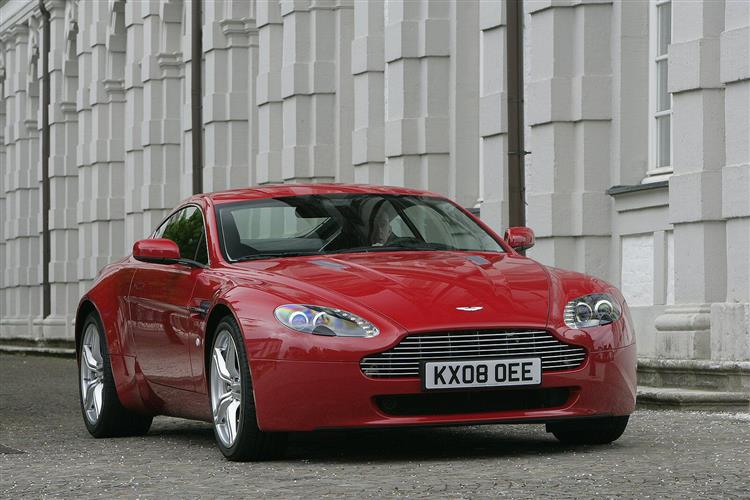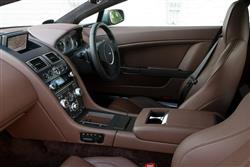ADVANTAGE ASTON (some text hidden) --NONE--
BY JONATHAN CROUCH
Introductionword count: 103
Aston Martin's Vantage is a modern high performance icon of unmistakable character, styled to seduce and engineered to thrill. In its day, it was always the most affordable supercar the British brand made, but many will tell you that it's arguably also the very best Aston from its era. There's a choice of either V8 or V12 power under the bonnet but either way, the performance is as sensational as the looks, either in Coupe form, or as a Roadster convertible. This was the first Aston Martin to directly take on Porsche and Maserati and it remains an emotional but very tempting choice.
Modelsword count: 18
2-door Coupe / Convertible [4.3 V8 / 4.7 V8 / 5.9 V12] / 2-door Coupe / 2-door Roadster
Historyword count: 396
There was a time late in the last century, when 'Aston Martin' meant something very different. An iconic British brand, to be sure, but a maker of hand built sportscars aimed at older buyers romanced by name and heritage in the face of compelling evidence that German and Italian rivals were better made and finer to drive. The gorgeous DB9 of 2003 was a sign that the future might be different but it was still an old-style GT rather than an out-and-out sportscar, the kind of design still most likely to appeal to Aston enthusiasts. A slightly smaller model with younger, more dynamic orientation was needed. A car that someone with little prior interest in the brand might buy. A car you could seriously choose over a Porsche 911 or a Maserati GT. A car like this one, Aston Martin's Vantage. Launched in 2005, this was the first thing the Gaydon factory had made that really worried German and Italian rivals. It was slightly more affordable for a start, so would sell in rather larger numbers than Aston's hand-built GTs further up the range. And it was fast, light on its feet and styled to be achingly desirable, either in coupe form or in subsequent open-topped Roadster guise. Rivals consoled themselves that the original model's 380bhp 4.3-litre V8 sounded faster than it actually went (though the special edition N400 variant of 2007 put out 400bhp). This overall issue was dealt with in 2008 with the installation instead of a 4.7-litre unit that boosted power by 11% to 420bhp. There was also a 430bhp V8 Vantage S model that many customers ended up choosing, which differed from the standard V8 with its bigger brakes, sharper suspension and steering and the standard inclusion of a 7-speed sequential shift semi-automatic gearbox. A special edition N420 model was introduced in 2010, while an N430 model arrived in 2015; both shared the V8S model's 430bhp engine but received various handling and bodystyle tweaks. Of course you don't have to have a V8 engine in your Vantage. There was also a V12 model, launched in 2009 with V10 and also available in coupe or Roadster guises mated to SportShift II auto transmission. In 2013, an uprated 565bhp V12 Vantage S variant was introduced. The modern-era Vantage sold in V8 and V12 guises until replaced by a new generation model in late 2017.
What You Getword count: 600
It's only when you put a Vantage up against one of Aston's other models that you really appreciate its differences in design. It's over a foot shorter than, say, a DB9 and 60mm lower slung. Put the two cars side by side and the DB9 is revealed as the GT car it is, while the Vantage sits foursquare, the big rear wheel arch bulges lending it a pugnacious muscularity. This is widely acclaimed as one of the world's most beautiful cars, a lesson in proportion, stance and sculptural form. The long, low bonnet line and broad rear haunches suggest power and aggression. Pure and understated, yet studded with simple, confident details, the Vantage is unmistakable Aston Martin. Subtle differences distinguish the three main coupe models, with 'S' and V12 models both showcasing aerodynamic refinements borrowed from the company's GT4 racing programme. At the front, a deeper bumper and a more aggressive carbon fibre splitter pluck more downforce from the airflow for increased stability at speed, while pronounced side sills reduce aerodynamic lift and give the flanks greater definition. At the rear, the tailgate is shaped into a more pronounced upswept 'flip' - again to reduce lift - and a carbon fibre diffuser helps extract air from beneath the car. Go for the gorgeous open-topped Roadster version and you get styling intended to evoke the look of 'an athlete wearing a skin-tight suit', an analogy that doesn't work quite as well as the Thinsulate fabric roof which can be raised or lowered in just 18s at speeds of up to 30mph and stores compactly when down beneath an aluminium tonneau cover. Interiors have never been an Aston Martin problem and from the moment that the gently assisted 'swan wing' door swings open in a graceful upwards arc and you slide into the supportive driver's seat that sets you low in the car, you know you're about to experience something very special. From the soft, supple hand-stitched leather that swathes the seats, dashboard and door panels to the intricate, aluminium-faced instruments designed to resemble the technical look of a chronograph watch, everything you touch and feel has been as carefully crafted as a Swiss watch or a Saville Row suit. We're not quite so sure though, about the ECU, or 'Emotional Control Unit', a square block that replaces a conventional ignition key or starter button and slots into the middle of the centre console to fire the engine. Overall, this cabin remains one of Aston's best efforts from this era, much of its architecture and components common with the DB9. That does mean, though, that this Vantage shares that car's problem in having rather too many knobs and buttons scattered around the dash in an age where cheaper brands habitually group all these functions within 'i-Drive'-type control systems. It unfortunately also shares the same fiddly Volvo-sourced optional satellite navigation system. Behind the front seats, there's no attempt to incorporate the tiny rear seats you find in larger Aston models, with instead a useful carpeted storage area big enough for a briefcase and complete with lovely aluminium roll-over spars. Doing without back seats has helped to optimise space for driver and passenger, meaning that there's enough head and leg room for six-footers, while the width of the cabin and the broad transmission tunnel will make banging elbows a distant memory. Out back, the 300-litre boot you get in the Coupe is big enough for two sets of golf clubs and significantly larger than you'll find on some rivals, though this capacity does fall to just 144-litres if you opt for the Roadster convertible.
To see the full road test text contact us on 0330 0020 227
Pictures (high res disabled)

.jpg)
|
.jpg)
|
.jpg)
| |||
.jpg)
|
.jpg)
|

|
Scoring (subset of scores)
Category: Sporting Cars
| Performance | |
| Handling | |
| Comfort | |
| Space | |
| Styling, Build, Value, Equipment, Depreciation, Handling, Insurance and Total scores are available with our full data feed. | |



